Kentucky Pesticide Safety Education Program

Questions?
Contact
Dr. Ric Bessin
Dept. of Entomology
University of Kentucky
859-257-7450
rbessin@email.uky.edu
Using Pesticide Formulations
Pesticide formulations are a combination of one or more active ingredients (a.i.), which control pests, and several inert ingredients. Many a.i.s are not soluble in water. Some may be toxic or unsafe to handle. Others may be unstable during storage. The inert ingredients are included in a formulated product to solve these problems. Some inert ingredients pose health risks to pesticide handlers or applicators so their characteristics, along with those of the active ingredient, determine the signal word that appears on the product label. For example:
4L = 4 pound per gallon Liquid
80 WP = 80% wettable powder
4L = 200 SL = 200 grams/liter (1.67 pounds/gal) soluble liquid
Pesticide products sold as concentrates must be mixed with water, or some other carrier, before being applied. The amount of active ingredient (a.i.) and the kind of formulation may be listed on the product label.
Concentrated formulations are very economical when treating large areas but it may be hard to measure amounts needed for small areas. Also, the handling, mixing, need for specialized spray equipment, and clean-up time may make the use of concentrates inconvenient or impractical.
Ready-to-Use formulations may be more appropriate for small areas. They contain small amounts of active ingredient (often 1% or less a.i. per unit volume). Some contain petroleum-based solvents; others are water-based. RTU formulations are already diluted and may be sold in containers that serve as applicators. Example RTU formulations include aerosols (A), granules (G), and most baits (B).
Most pesticide formulations are liquid or dry materials. Some pesticides are available in more than one. Cost is always a consideration but safety and pest management concerns should come first. Choose the formulation best suited for the job based on:
- Legal, labeled uses
- Signal word
- Applicator safety
- Environmental safety
- Pest biology
- Site characteristics
- Target (surface to be treated)
- Application equipment
Answering these questions can help with the decision:
- Is the intended use and site listed on the product label?
- Do I have the necessary application equipment?
- Can the formulation be applied appropriately under the conditions in the application area?
- Will the formulation reach the intended target and stay in place?
- Is the formulation likely to damage the surface or foliage being treated?
- Would a less hazardous formulation be as effective?
[return]
Liquid Formulations
Most liquid formulations are diluted with water to make a finished spray. However, some labels direct users to mix the product with another solvent such as crop oil or other light oil as a carrier.
The three main types of liquid formulations are solutions, suspensions, and emulsions:
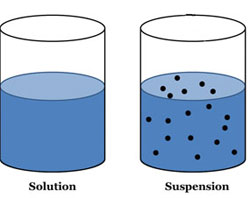 A solution is made by dissolving a substance in a liquid. A true solution is a mixture that cannot be separated by a filter or other mechanical means. Normally, it will not separate or "settle out" into distinct parts after being mixed. Light can penetrate most solutions.
A solution is made by dissolving a substance in a liquid. A true solution is a mixture that cannot be separated by a filter or other mechanical means. Normally, it will not separate or "settle out" into distinct parts after being mixed. Light can penetrate most solutions.
A suspension is an even mixture of very small solid particles throughout a liquid. A suspension that has been on a shelf for some time must be shaken well to mix the liquid and solid portions evenly before pouring it into the spray tank. Water is added to make a finished spray. There must be enough agitation to keep the product evenly distributed in the spray tank during application. Most suspensions are cloudy or opaque; light cannot pass through them.
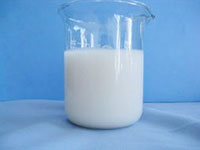 An emulsion is a mixture of droplets of one liquid in another liquid. Each ingredient keeps its unique properties and identity.
An emulsion is a mixture of droplets of one liquid in another liquid. Each ingredient keeps its unique properties and identity.
In an emulsion, the active ingredient is dissolved in an oil-based solvent. An emulsifier allows the active ingredient and the solvent to mix evenly with water before application. Some agitation may be necessary to keep an emulsion from separating. As a rule, emulsions have a "milky" appearance.
Common Liquid Formulations
Emulsifiable Concentrate (E or EC)
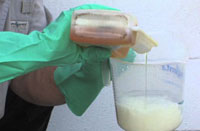 EC formulations usually contain an oil-soluble liquid active ingredient, a petroleum-based solvent, and an emulsifier (mixing agent). The emulsifier allows the active ingredient in the solvent to mix with water, these form an emulsion. ECs are versatile formulations that can be applied with many types of sprayers.
EC formulations usually contain an oil-soluble liquid active ingredient, a petroleum-based solvent, and an emulsifier (mixing agent). The emulsifier allows the active ingredient in the solvent to mix with water, these form an emulsion. ECs are versatile formulations that can be applied with many types of sprayers.
Formulation
|
Advantages
|
Disadvantages
|
|
|
Easily absorbed through skin; High concentration; Easy to over-treat or under-treat through mixing or calibration errors; May burn tender plant foliage; May soften rubber or plastic hoses, gaskets, and pump parts; May be corrosive to eyes or skin |
Solutions (S, CS)
Some pesticide active ingredients dissolve readily in a liquid solvent, such as water or a petroleum-based diluent. When mixed, they form a solution that does not settle out or separate. Formulations of these pesticides usually contain the active ingredient, solvent (carrier or diluent), and one or more other ingredients. No emulsifier is required. Solutions are suitable for any type of sprayer and are registered for many sites.
Formulation
|
Advantages
|
Disadvantages
|
|
|
Limited availability; Spills and splashes difficult to clean-up or decontaminate |
Emulsions in Water (EW)
An emulsion in water formulation is the dispersion of a liquid active ingredient in water. These formulations have reduced dermal toxicity and lower potential for harming the environment. EWs are less likely to damage tender plant foliage because they do not contain the solvents found in emulsifiable concentrates.
Flowables (F, L, or SC)
Some active ingredients will not dissolve in either water or oil so they are impregnated in a dry carrier, such as clay, which is ground into a fine powder. The powder is suspended in a small amount of liquid to make the thick liquid formulation. Abbreviations used include "F" for flowable, "L" for liquid, and "SC" for suspension concentrate. The abbreviations 4F or 4L mean 4 pounds of the a.i. per gallon. They are considered to be liquids because the end use product is a thick liquid. Flowables are often used for the same types of pest control operations as ECs.
Formulation
|
Advantages
|
Disadvantages
|
|
|
Easy to handle and measure;Seldom burns plant foliage;Easy to tank mix; No dust exposure for applicator | Low absorption into skin; Will settle, requires moderate agitation; May leave a visible residue; May wear spray nozzles |
Microencapsulated Pesticides (M or ME)
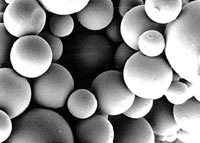 These are dry particles or liquid droplets surrounded by a plastic, starch or other material coating. They are mixed with water and applied as sprays. After application, there is a "timed" or slow release of the a.i. Depending on the physical properties of the coating, release may be weather-dependent. If the release is slower than normal (for example, due to dry or cool weather), residues may remain on treated plants or surfaces longer than expected. As a result, some microencapsulated products have relatively long restricted-entry or pre-harvest intervals.
These are dry particles or liquid droplets surrounded by a plastic, starch or other material coating. They are mixed with water and applied as sprays. After application, there is a "timed" or slow release of the a.i. Depending on the physical properties of the coating, release may be weather-dependent. If the release is slower than normal (for example, due to dry or cool weather), residues may remain on treated plants or surfaces longer than expected. As a result, some microencapsulated products have relatively long restricted-entry or pre-harvest intervals.
Some microencapsulated pesticide products contain highly toxic materials with coatings to increase handler safety. Others are microencapsulated to reduce staining or odor or to protect the active ingredient from breakdown by sunlight. Microencapsulated insecticides may be very hazardous to bees if the particles do not break down quickly and are the same size as pollen grains. Foraging bees may collect them and carry them back to the hive. Later, when the coatings break down and release the pesticide, the colony may be poisoned. Some microencapsulated soil-applied products may be more prone to leaching into groundwater.
Formulation
|
Advantages
|
Disadvantages
|
|
Safer handling; Longer residual control; Reduced plant injury (burn) |
Pollen size particles are a bee hazard; Require agitation; Slower breakdown may cause higher residue at harvest |
Aerosol (A)
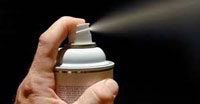 These formulations contain one or more active ingredients and a solvent. Most aerosols contain a low percentage of active ingredient. There are two types of formulations.
These formulations contain one or more active ingredients and a solvent. Most aerosols contain a low percentage of active ingredient. There are two types of formulations.
- Ready-to-use (RTU) aerosol formulations are usually small, self-contained units that release pesticide when the nozzle valve is triggered. An inert pressurized gas pushes the pesticide through a fine opening when the gas is released, creating fine droplets. These products are effective in greenhouses, in small areas inside buildings, or in localized outdoor areas. Commercial models, which hold 5 to 10 pounds of pesticide, are usually refillable.
- Smoke or Fog Generator formulations are used in machines that use a rapidly whirling disk or heated surface to produce and distribute very fine droplets. These formulations are used mainly for insect control in structures such as greenhouses, barns, and warehouses and for outdoor mosquito and biting fly control. Both provide easy ways to treat confined spaces but have high inhalation hazards and aerosols have a high risk of fire/explosion.
[return]
Dry Formulations
The active ingredient is on the surface of a solid carrier, such as talc, clay, or ground corncobs.
Granules (G)
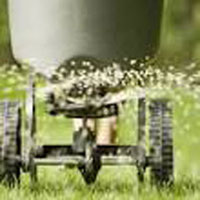 Granules are ready-to-use formulations. The active ingredient either coats the outside of the granules or is absorbed into small particles of clay, talc, or similar carrier. The amount of active ingredient is relatively low, usually ranging from less than 1% to 15%. The carriers in many granular formulations absorb moisture so humidity affects their flow rate during application. Also, different "batches" of the same formulation may differ slightly in size or shape and density. Therefore, it is important to calibrate granular application devices often.
Granules are ready-to-use formulations. The active ingredient either coats the outside of the granules or is absorbed into small particles of clay, talc, or similar carrier. The amount of active ingredient is relatively low, usually ranging from less than 1% to 15%. The carriers in many granular formulations absorb moisture so humidity affects their flow rate during application. Also, different "batches" of the same formulation may differ slightly in size or shape and density. Therefore, it is important to calibrate granular application devices often.
After application, the active ingredient is slowly released. Rainfall or watering usually is needed to activate the product. Granular formulations are mostly used to apply chemicals to the soil to control weeds, nematodes, or soil insects. Granular formulations are used to deliver systemic pesticides which are taken up by plant roots. They also are used in aquatic situations to control mosquito larvae and aquatic weeds.
Formulation
|
Advantages
|
Disadvantages
|
G
|
Carries the
formulation to target; May break down more slowly
|
Needs moisture for
activation; Potential bird ingestion hazard
|
Wettable Powders (WP or W)
Active ingredients are applied to finely ground talc or clay particles. Most WP formulations also include wetting and/or dispersing agents. Usually, they are mixed with water to form a suspension and applied as a spray. They will settle quickly without constant agitation. To prepare a spray suspension, you must form a slurry by mixing the WP with a small amount of water, then dilute this slurry mixture further.
Wettable powders are effective for most pest problems and in most types of spray equipment where agitation is possible. They have excellent residual activity and usually do not harm treated surfaces. When you apply a WP spray suspension to a target, most of the pesticide remains on the surface. This is true even for porous materials, such as concrete, plaster, and untreated wood. In such cases, only the water carrier penetrates the porous material. Wettable powder particles remain on the treated surface.
Formulation
|
Advantages
|
Disadvantages
|
|
Low skin absorption; Low potential to burn foliage
|
High inhalation hazard when pouring and mixing; Requires good agitation in spray tank; Abrasive to nozzles and sprayer parts (not SP) |
Soluble Powder (SP or S)
These formulations look like wettable powders. However, when mixed with water, soluble powders dissolve readily in water and form a true solution. After a thorough mixing, no additional agitation is necessary. The amount of active ingredient in soluble powders ranges from 15% to 95%; it usually is more than 50%. Soluble powders have all the advantages of WPs but only one of the disadvantages: inhalation hazard during mixing. The insecticide acephate is one of the few pesticides available in this formulation because very few active ingredients dissolve in water.
Water-Dispersible Granules (WDG) or Dry Flowables (DF)
 These are WP formulations that have been compressed into dust-free, granule-sized particles. Most come with product-specific measuring devices. The dry ounce (or pound) increment marks on them are based on product density (weight per unit volume).These formulations readily pour out of their containers and are are easier to measure and cleaner to handle than WPs. They too are mixed with water and applied as a spray suspension. Once in water and agitated, the granules break apart into fine powder. The label may contain specific instructions to make mixing more effective. These formulations require constant agitation to keep them suspended in water.
These are WP formulations that have been compressed into dust-free, granule-sized particles. Most come with product-specific measuring devices. The dry ounce (or pound) increment marks on them are based on product density (weight per unit volume).These formulations readily pour out of their containers and are are easier to measure and cleaner to handle than WPs. They too are mixed with water and applied as a spray suspension. Once in water and agitated, the granules break apart into fine powder. The label may contain specific instructions to make mixing more effective. These formulations require constant agitation to keep them suspended in water.
WDGs share the advantages and disadvantages of WPs. However, WDGs have one added benefit: reduced handler exposure risk. A label for an 80 WDG indicates that this dry product contains 80% by weight of active ingredient and is formulated as a water-dispersible granule.
Formulation
|
Advantages
|
Disadvantages
|
|
Low skin absorption; Low potential to burn foliage
|
High inhalation hazard when pouring and mixing; Requires good agitation in spray tank; Abrasive to nozzles and sprayer parts |
Water-Soluble Bags/Packages (WSB)
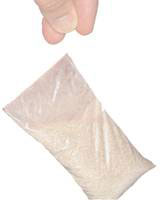 An increasing number of pesticide products are available in water-soluble bags (WSBs). A special film packages a precise amount of wettable powder, soluble powder, or gel containing the pesticide active ingredient(s). When added to water in a spray tank, the bag dissolves and releases the contents that then are suspended or dissolved. This packaging method reduces handler exposure risk. It also simplifies measuring.
An increasing number of pesticide products are available in water-soluble bags (WSBs). A special film packages a precise amount of wettable powder, soluble powder, or gel containing the pesticide active ingredient(s). When added to water in a spray tank, the bag dissolves and releases the contents that then are suspended or dissolved. This packaging method reduces handler exposure risk. It also simplifies measuring.
Water-soluble packaging will not dissolve in organic solvents or undiluted ECs. As a result, mixers and loaders must follow label instructions when preparing a spray mixture. Store water-soluble products in a dry place, and do not handle them with damp or wet gloves. Packets contain amounts of pesticide for specific spray volumes, such as 100 gallons of water.
Formulation
|
Advantages
|
Disadvantages
|
WSB or WSP
|
Safe handling; Precise pre-measured amounts |
Suitable for specific volumes only; Packets may deteriorate or tear. |
Baits (B)
These are RTU formulations containing an active ingredient mixed with food or another attractive substance. The bait either attracts the pests or is placed where the pests will find it. Application may require specialized equipment and treatment costs may be too great for problems such as slug control in no-till corn or soybeans.
[return]
Pesticide Tank Mixtures
Combining two or more pesticides in a tank mix can be convenient and cost-effective, saving time, labor, fuel, and equipment wear. Combined applications also reduce soil compaction and the risk of mechanical damage to crops or treated areas. Situations appropriate for tank mixing include combining a fungicide and insecticide to treat fruit trees or field crops or to combine two (2) or more herbicides to increase the number of weed species controlled (broadened control spectrum).
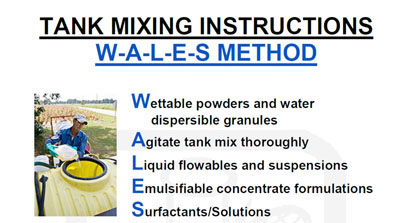
Manufacturers may combine two or more pesticides, commonly applied at the same time, in premix packages. If a desired premix is not available, Federal law allows you to combine two or more pesticides unless the labeling of one or more of the intended products specifically prohibits it. For example, some sample tank mix warnings might include:
In a tank mixture, observe all restrictions, directions for use, crop/sites, use rates, dilution ratios, precautions and limitations that appear on the tank mix product label.
*****
Do not exceed labeled dosage rate and follow the most restrictive label precautions and limitations. This product must not be mixed with any product that prohibits such mixing.
*****
Tank mixtures or other applications of products referenced on this label are permitted only in those states in which the referenced products and uses are registered.
Compatibility of Pesticide Mixes
Pesticides must be compatible in order to provide effective pest control. If the labels do not give mixing instructions but do not prohibit it, then you are responsible for
- determining compatibility by "jar testing" the combinations. AND
- checking for phytotoxicity (plant injury) by testing the mixture on a small number of plants.
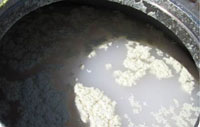

Pesticides can be incompatible for one of two main reasons:
- physical - they gel, curdle, foam, or stay in separate layers when mixed.
- chemical - their pest control activity changes when they are mixed.
Antagonism and synergism are the main types of chemical incompatibility. Antagonism occurs when the pest control effectiveness of one or both mixed products is reduced. Synergism occurs when mixing increases the activity of one or more products. This can produce more effective pest control in some cases but in other cases, the result can be crop damage.
[return]
Additives / Adjuvants
Additives / adjuvants are chemicals that may improve the action of a pesticide OR change the characteristics of a pesticide formulation or a spray mixture. Before using any adjuvant, consult the pesticide product label. Some products have very specific recommendations or prohibitions for adjuvants. If a label instructs you to use an adjuvant, use the type called for at the directed rate. Many products already contain those adjuvants that the manufacturer or formulator feels are necessary or useful. Adding others may actually decrease efficacy or result in unintended and possibly undesirable effects.
Adjuvants alone have no pesticidal activity so the EPA does not register them. As a result, there are no standards for composition, quality, or performance. Contact the manufacturer if you have questions about an adjuvant.
Types of Adjuvants
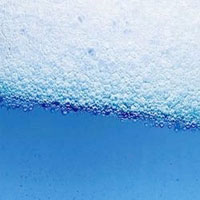 Antifoaming (defoaming) agent reduces excessive foaming of spray mixtures that may result from using some surfactants and/or from vigorous agitation.
Antifoaming (defoaming) agent reduces excessive foaming of spray mixtures that may result from using some surfactants and/or from vigorous agitation.
Buffer or pH modifier allows pesticides to mix with diluents or other pesticides of different acidities or alkalinities. A buffer should be added first and mixed well. The water must be pH neutral or slightly acidic before adding pesticides or other adjuvants.
Compatibility agent helps to combine pesticides (or pesticides and fertilizers) effectively; they can reduce or eliminate mixing problems.
Drift control additive (deposition aid) increases average droplet size and/or lower the number of "fines" (very small droplets) produced.
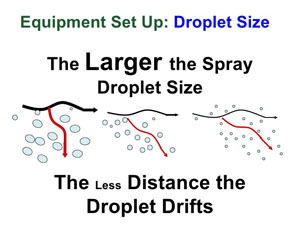
Extender or sticker keeps pesticides active on a target for an extended period or on waxy foliage.
Plant penetrant allows pesticides to entered treated foliage. Certain plant penetrants may increase movement into leaves of some but not all plant species.
Safener reduces the toxicity of a pesticide formulation to the pesticide handler or to the treated surface.
Spreader allows a pesticide to form a uniform layer over a treated surface.
Sticker allows pesticides to stay on a treated surface longer. Some stickers help to hold solid particles to treated surfaces. This reduces the amount that washes off due to rain or irrigation. Others reduce evaporation and/or slow breakdown by sunlight.
Thickener increases viscosity (thickness) of spray mixtures. They may reduce drift and/or slow evaporation.
Wetting agent allows WP formulations to mix with water.
Surfactants are commonly used as adjuvants to alter the dispersal, spreading, and wetting properties of spray droplets. These products physically change the surface tension of a spray droplet. In order to perform well, some pesticide sprays must be able to wet treated foliage thoroughly and evenly. Surfactants that reduce surface tension enable droplets to spread out instead of "beading up". This results in better coverage and increases the odds that the pest will contact the pesticide. Surfactants are particularly helpful when treating plants with waxy or hairy leaves.

Surfactants are classified by how they split apart into charged atoms or molecules, called ions.
- Anionic surfactants have a negative (-) charge. They are most often used with contact pesticides, which control the pest by direct contact instead of being absorbed into it systemically.
- Cationic surfactants have a positive (+) charge. Do not use them as "stand-alone" surfactants-often, they are phytotoxic.
- Nonionic surfactants have no electrical charge. They are often used with systemic products to help pesticides to penetrate plant cuticles. They are compatible with most pesticide products. A pesticide can behave very differently in the presence of an anionic, cationic, or nonionic surfactant. For this reason, you must follow label directions when choosing one of these additives. Selecting the wrong surfactant can reduce efficacy and damage treated plants or surfaces.
The terms used with pesticide additives can be confusing. People sometimes use the words "adjuvant" and "surfactant" interchangeably. However, an adjuvant is ANY substance added to modify properties of a pesticide formulation or finished spray. A surfactant is a specific kind of adjuvant-one that affects the interaction of a spray droplet and a treated surface. All surfactants are adjuvants but not all adjuvants are surfactants. For example, drift control additives and safeners are not surfactants.
Choosing an Adjuvant
- Read and follow the label. Is an adjuvant recommended? If so, what type? Do not make substitutions. Some product labels may recommend an adjuvant for one type of use or site but prohibit any kind of adjuvant for another labeled use or site. Many end-use formulated products already have adjuvants, and adding adjuvants "on the fly" can decrease efficacy. Suppose, for example, that a certain product is formulated with a wetting agent. If you add another wetting agent when you mix and load a foliar-applied spray, the product may not give better spreading and coverage. Instead, the extra adjuvant may increase runoff, reduce deposition, and even damage the target plant.
- Use only those adjuvants manufactured for agricultural or horticultural uses. Do not use industrial products or household detergents in pesticide spray mixes.
- No adjuvant is a substitute for good application practices.
- Be skeptical of adjuvant claims such as "improves root uptake" or "keeps spray equipment clean" unless a reliable source can provide research-based evidence to support them. Only use adjuvant products that have been tested and found effective for your intended use.
- Test spray mixes with adjuvants on a small area before proceeding with full-scale use.
[return]
Summary
The components of a formulated pesticide include both active and inert ingredients. The active ingredient controls the pest. Inert ingredients include carriers or diluents and adjuvants. The type of formulation may be provided in the identifying information on the front panel of the label. Learn what formulations are available for the pesticide active ingredients you will use. To decide which formulation is best for a specific site and situation, you must know the properties-and be able to evaluate the pros and cons-of various formulation types. You must be familiar with formulation types and active ingredient properties in order to understand the characteristics of the products you use and apply them properly.
Most end-use pesticide products contain adjuvants. Although adjuvants themselves lack any direct pesticidal activity, they are added to pesticide formulations to improve product performance. You should know when and how to use an adjuvant.
You must consider several factors when choosing a pesticide formulation. These include
- the risks and benefits associated with the options available,
- the practicality of using a specific formulation in a particular site to control the target pest, and
- whether the formulated product will provide effective control.
Understanding the properties of common formulations before choosing a pesticide will help you avoid problems and apply your product in an effective and efficient manner.
[return]
1) Which one of the following pesticide formulations requires no agitation in the spray tank?
2) Which formulation poses the greatest inhalation danger to the applicator?3) Which formulation is most easily absorbed if spilled onto the skin?
4) The name "X-Pest 0.5G" on a pesticide label indicates a :- Granular with 0.5% active ingredient
- Granular with 5% active ingredient
- Gel pesticide with 5% active ingredient
- None of the above
5) Which is the pesticide formulation in which solid particle are dispersed in a liquid?
6) Which dry/solid formulation is mixed in water and has a reduced risk of inhalation exposure during mixing and loading?
7) Which is an advantage of microencapsulated materials?
- They require no agitation
- Safer for use if bees or other pollinators are active
- They have a very short pre-harvest interval
- Delayed or slow release of the active ingredient
8) Which type of adjuvant acts as a wetting agent and spreader (i.e. alters the surface tension of spray droplets)?
9) Which type of adjuvant increases the viscosity of spray mixtures?
10) Which formulation is most likely to burn plant foliage?
11) The carrier in this formulation may absorb moisture. This can change the prduct flow rate, so application devices must be calibrated often.
12) It is always illegal to combine two (2) or more pesticides in a spray tank unless there are specific mixing instructions on the labels of both products.
13) If a gel forms after two (2) pesticides are put together in a "jar test" then the problem is ______________ incompatibility.
14) ______________ occurs when the pest control effectiveness of one or both mixed pesticides is reduced.
15) All adjuvants/additives used in pesticide applications must be registered with the EPA.
16) A _______ is used to help reduce mixing problems when combining pesticides, or pesticides and fertilizers.
17) A ____________ surfactant is generally used with systemic pesticide products to get better plant penetration.
18) The ______________ is the part of a pesticide formulation that provides pest control.
19) Most pesticide formulations do not contain adjuvants so they must be added by the applicator.
20) Signal words on pesticide labels are based on both the active and inert ingredients in the product.
Photo credits: EC Formulation (University of Florida) | Aerosol spray, Granular pesticide (Texas A&M) | WDG formulation (Valent Biosciences Corp.) | WALES method (University of Georgia) | Incompatible mixes (ONvegetables.com; University of Minnesota | antifoaming agent (indiamart.com) | Droplet size (A. Ansari, Washington State University | Surfactant (G-Planter.com)
website content by L. Townsend website designed by P.M. Dillon copyright © 2017 University of Kentucky Department of Entomology
University of Kentucky College of Agriculture |
S-225 Agricultural Science Center North, Lexington, KY 40546-0091 | 859.257.7450
An Equal Opportunity University |
Last modified
11/30/2018
